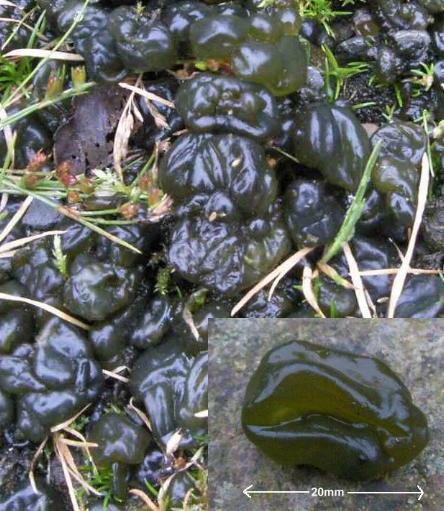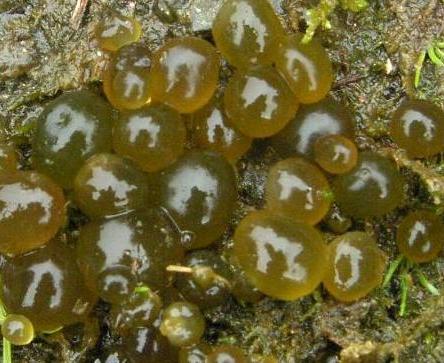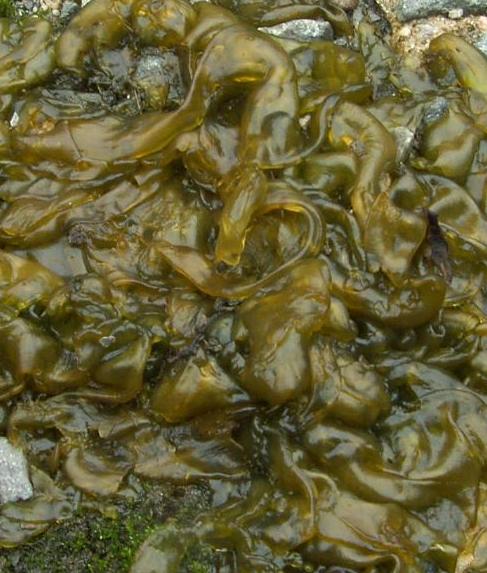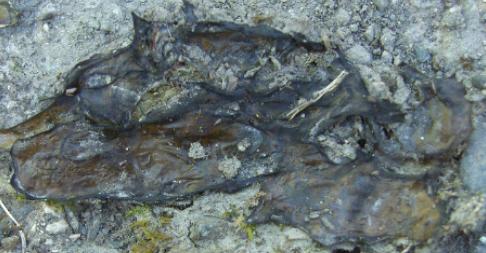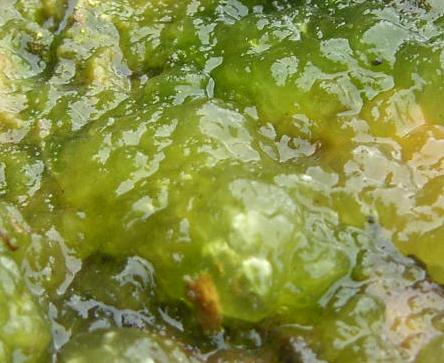Blue-green AlgaeScientific Name: Nostoc species |
This algal growth may not be considered as a 'weed' in the traditional sense, but is included here as it appears from time-to-time in the garden. After rain, it can suddenly appear, apparently from nowhere, on paths, on roofs and sometimes in poorly-growing lawns. This gave rise to an early belief that it was debris from shooting stars that had fallen to earth, hence some of the common names.
The genus Nostoc contains Blue-green algae which are composed of colonies of Cyanobacteria arranged in strings or filaments called trichomes which are surrounded by a thin sheath. They can be found in water and on land, and are able to withstand extreme environments such as the freezing Arctic or the hot pools near an active volcano - for this reason they are known as extremophiles. They also have the ability to lie dormant for long periods when conditions are unfavourable and come back to life when rehydrated.
Aquatic forms are responsible for the algal blooms which appear in water bodies. These can be hazardous to other wildlife and in inland water are toxic to animals which ingest them as they drink or accidently when swimming. It can cause liver or neurological damage leading to seizures - dogs are particularly susceptible. By blocking light from lower levels oxygen is depleted causing fish to die. The main cause of algal blooms is the phosphate in runoff water from intensively managed agricultural land.
The Cyanobacteria can fix nitrogen from the atmosphere and are able to use energy from the sun, but not with the same pigments as the photosynthesis carried out by the chloroplasts in plant cells. Their photosynthesising pigments are free in the cytoplasm and not contained within an organelle such as the chloroplast. They can be the photobiont in Lichens.
Some of the pigments they contain can absorb UV-A/B which protects them from exposure to intense sunlight. It is the carotenoid pigments of aquatic Blue-green algae which give Flamingos their distinctive pink colouration so they have to receive the algae, or crustaceans which have fed on them, in their diet or their feathers fade to white.
Geological studies have found that oxygen-producing cyanobacteria were present about 2.8 billion years ago and are probably responsible for the creation of the life-supporting atmosphere of the Earth. They have survived catastrophic phases in our evolutionary history, such as large scale volcanic activity and total icing over of the planet. The light reactive molecules they use are similar to the rhodopsin protein which acts in the light sensitive receptors in our eyes. This gives a link back to when these chemicals first appeared and have remained in the genetic code of cells enabling animals to develop sight.
The chloroplasts in plants and similar organelles in algae, have evolved from Cyanobacteria and became enveloped in the cells at some point in their evolutionary history.
The pictures on the right show three forms of terrestrial blue-green algae. The top two show one form taken at different levels of hydration which is arranged in rounded beads that contain a clear gel-like core when hydrated.
The middle one, Nostoc commune, is made up of folded rubbery sheets when hydrated, which dry to a crispy sheet, shown below. It was once thought to be related to seaweed because of its physical appearance, but this is not the case.
The bottom picture is a form with a loose gel arrangement with no distinct boundaries.
Blue-green algae have been used in Asia as a herbal medicine for centuries and recent studies have found properties of pharmacological interest with compounds which can kill cancer cells and HIV. The omega 3 and vitamin B12 they contain are not uptaken to any extent by humans, but are available to the organisms lower in the food chain which consume them.
Spirulina, chlorella and klamath are all cyanobacteria which are not toxic and contain abundant supplies of proteins, vitamins, minerals, carotenoids, and antioxidants. For this reason they are taken as supplements or included as ingredients to make novel foods, Chlorella is more green and Spirulina more blue and are used to prepare green or blue breads, smoothies or desserts. With emulsifying properties they can be used instead of eggs to make mayonnaise. They are particularly useful in vegetarian and vegan diets although it should be used sparingly at first to avoid stomach cramps and as they have high levels of vitamin K they will interfere with blood thinners.
Although algal blooms are not welcome in waterways and ponds, they can be grown in large vats and harvested to be converted into green fuel. As well as capturing harmful carbon dioxide from the atmosphere, this method of biomass production for fuel can be carried out in desert areas where sunlight is plentiful and land for food production is spared. The rapid growth of the algae makes it more productive than using soya or other feed crops for conversion to fuel. Some researchers at Cambridge University are examining the possibility of using photo-bioreactors in the domestic situation where the algae would be grown in transparent tubes to produce hydrogen for use as fuel; this is given the name "Algaetecture" (from algae and architecture). Also similar devices could be used to convert carbon dioxide and other waste products to biomass which could be used as fuel.
When dry they can look unsightly and when wet they can be very slippery. The bead-like form can be swept up and the rubbery sheets are easily lifted. The loose jelly can be swept up as well. On hard surfaces bleach (20% Sodium Hypochlorite dairy cleanser from farm suppliers) applied to the hydrated algae, or another such cleaner should kill any that remains. 3% Hydrogen Peroxide is also effective. Improve the drainage and fertility in the lawn to discourage its growth.
See also the monographs on Dog Lichen, Liverwort and Moss which may be found in similar locations and are discouraged by the same methods.
Follow these links for further details on Weeds, Weed Removal and Weed Prevention, or use the drop-down menus at the top of the page to find articles on garden-related topics.
The pictures below show Blue-green algae in different forms and states of hydration:
